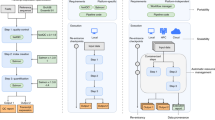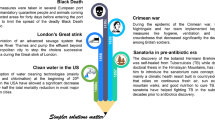Abstract
The need to turn raw data into knowledge has led the bioinformatics field to focus increasingly on the manipulation of information. By drawing parallels with both cryptography and artificial intelligence, we can develop an understanding of the changes that are occurring in bioinformatics, and how these changes are likely to influence the bioinformatics job market.
This is a preview of subscription content, access via your institution
Access options
Subscribe to this journal
Receive 12 print issues and online access
$189.00 per year
only $15.75 per issue
Buy this article
- Purchase on Springer Link
- Instant access to full article PDF
Prices may be subject to local taxes which are calculated during checkout
Similar content being viewed by others
References
Edman, P. & Begg, G. A protein sequenator. Eur. J. Biochem. 1, 80–91 (1967).
Huang, X. C., Quesada, M. A. & Mathies, R. A. DNA sequencing using capillary array electrophoresis. Anal. Chem. 64, 2149–2154 (1992).
Maxam, A. M. & Gilbert, W. A new method for sequencing DNA. Proc. Natl Acad. Sci. USA 74, 560–564 (1977).
Saiki, R. K. et al. Primer-directed enzymatic amplification of DNA with a thermostable DNA polymerase. Science 239, 487–491 (1988).
Sanger, F., Nicklen, S. & Coulson, A. R. DNA sequencing with chain-terminating inhibitors. Proc. Natl Acad. Sci. USA 74, 5463–5468 (1977).
Reese, M. G. et al. Genome annotation assessment in Drosophila melanogaster. Genome Res. 10, 483–501 (2000).
Huang, X. An improved sequence assembly program. Genomics 33, 21–31 (1996).
Huang, X. & Madan, A. CAP3: a DNA sequence assembly program. Genome Res. 9, 868–877 (1999).
Huson, D. H. et al. Design of a compartmentalized shotgun assembler for the human genome. Bioinformatics 17, S132–S139 (2001).
Kent, W. J. & Haussler, D. Assembly of the working draft of the human genome with GigAssembler. Genome Res. 11, 1541–1548 (2001).
Myers, E. W. et al. A whole-genome assembly of Drosophila. Science 287, 2196–2204 (2000).
Weber, J. L. & Myers, E. W. Human whole-genome shotgun sequencing. Genome Res. 7, 401–409 (1997).
Discala, C., Benigni, X., Barillot, E. & Vaysseix, G. DBcat: a catalog of 500 biological databases. Nucleic Acids Res. 28, 8–9 (2000).
Fitch, W. M. Distinguishing homologous from analogous proteins. Syst. Zool. 19, 99–113 (1970).
Fitch, W. M. Homology — a personal view on some of the problems. Trends Genet. 16, 227–231 (2000).
Bairoch, A. & Apweiler, R. The SWISS-PROT protein sequence database and its supplement TrEMBL in 2000. Nucleic Acids Res. 28, 45–48 (2000).
Gerlt, J. A. & Babbitt, P. C. Can sequence determine function? Genome Biol. 1, S0005.1–S0005.10 (2000).
Bork, P. & Bairoch, A. Go hunting in the sequence databases but watch out for the traps. Trends Genet. 12, 425–427 (1996).
Karp, P. What we do not know about sequence analysis and sequence databases. Bioinformatics 14, 753–754 (1998).
Attwood, T. K. & Miller, C. J. Which craft is best in bioinformatics? Comput. Chem. 25, 329–339 (2001).
Gruber, T. R. Towards principals for the design of ontologies used for knowledge sharing. Int. J. Hum. Comput. Stud. 43, 907–928 (1995).
Rich, E. & Knight, K. Artificial Intelligence (McGraw-Hill, New York, 1991).
Ringland, G. A. & Duce, D. A. Approaches to Knowledge Representation: An Introduction (John Wiley, New York, 1988).
Smith, M. Station X: The Codebreakers of Bletchley Park (Channel 4 Books, Macmillan Publishers Ltd, London, 1998).
Altschul, S. F., Gish, W., Miller, W., Myers, E. W. & Lipman, D. J. Basic local alignment search tool. J. Mol. Biol. 215, 403–410 (1990).
Guha, R. V. & Lenat, D. B. Cyc: a midterm report. AI Magazine Fall (Autumn), 32–59 (1990).
Wood, M. M. in Joint Conference on Information Sciences Vol. 2 (ed. Wang, P. P.) 75–78 (Duke Univ., North Carolina, 1997).
Stoesser, G. et al. The EMBL nucleotide sequence database. Nucleic Acids Res. 30, 21–26 (2002).
Brenner, S. Life sentences: ontology recapitulates philology. Genome Biol. 3, 1006.1–1006.2 (2002).
Wheelan, S. J. & Boguski, M. S. Late night thoughts on sequence annotation. Genome Res. 8, 168–169 (1998).
Smith, R. F. Perspectives: sequence database searching in the era of large-scale genomic sequencing. Genome Res. 6, 653–660 (1996).
Brazma, A. et al. Minimum information about a microarray experiment (MIAME) —toward standards for microarray data. Nature Genet. 29, 365–371 (2001).
Woods, W. A. What's in a Link: Foundations for Semantic Networks (eds Bobrow, D. & Collins, A.) 35–82 (Academic Press, New York, 1975).
Brachman, R. J. On the Epistemological Status of Semantic Networks (ed. Findler, N. V.) (Academic Press, New York, 1979).
Brachman, R. J. What IS-A is and isn't: an analysis of taxonomic links in semantic networks. IEEE Comput. 16, 30–36 (1983).
Brachman, R. J. I lied about the trees. AI Magazine 6, 80–85 (1985).
Samuel, A. Some studies in machine learning using the game of checkers II — recent progress. IBM J. 11, 601–617 (1967).
Burmeister, J. & Wiles, J. An Introduction to the computer GO filed and associated Internet resources Technical report 339 (Department of Computer Science, Univ. of Queensland, Australia, 1995).
Campbell, M. S. in HAL's Legacy: 2001's Computer as Dream and Reality (ed. Stork, D. G.) 76–98 (MIT Press, Cambridge, Massachusetts, 1997).
Hodges, A. Alan Turing: The Enigma of Intelligence (Unwin, London, 1985).
Salton, G. The SMART Retrieval System — Experiments in Automatic Document Processing (Prentice Hall Inc., Englewood Cliffs, New Jersey, 1971).
Author information
Authors and Affiliations
Corresponding author
Related links
Glossary
- ANNOTATION
-
The explanatory notes accompanying a database entry that describe, for example, the function of a protein (either determined experimentally, or by the predictions of bioinformatics algorithms), bibliographic references and links to other databases.
- CRYPTOGRAPHY
-
The practise and study of encryption and decryption: encoding data so that it can only be decoded by specific individuals.
- MACHINE TRANSLATION
-
The use of computers to provide automatic translation from one natural language to another.
- ONTOLOGY
-
A machine-readable representation of complex information that can be manipulated by a computer program.
- REASONING ENGINE
-
The software required to form logical relationships between entries in an ontology and to make deductions about them.
- SEMANTICS
-
The meaning of a fragment of language (as opposed to syntax, which describes how symbols in that language might be legitimately combined, independent of their meaning). The distinction between syntax and semantics allows linguists to deal with sentences such as 'colourless green ideas sleep furiously', which are syntactically correct, but meaningless.
- SYMBOL
-
An entity represented in such a way that a computer program can manipulate it. This might be a word, such as 'cat' or 'dog', a node in a graph or an entry in a database. Because they 'stand for' something else, such representations are referred to as symbols and the programs that deal with them do so by a process of 'symbol manipulation'.
- TERMINOLOGY
-
A predefined set of keywords and terms used, for instance, to annotate a database.
Rights and permissions
About this article
Cite this article
Miller, C., Attwood, T. Bioinformatics goes back to the future. Nat Rev Mol Cell Biol 4, 157–162 (2003). https://doi.org/10.1038/nrm1013
Issue Date:
DOI: https://doi.org/10.1038/nrm1013



